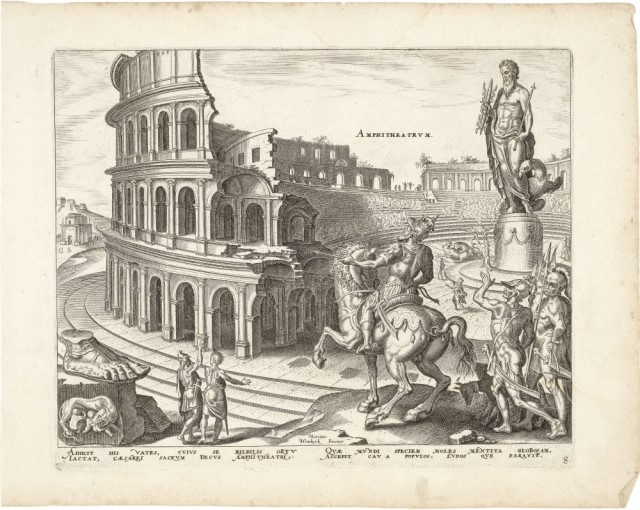Wonders of the World (complete set) 1572
Philips Galle
* 1537 in Haarlem † 1612 in Antwerp
Complete set of eight engravings after Maarten van Heemskerck (1498 – 1574).
Published by Theodor Galle. Dated 1572 on plate 7. The captions for the series are by the humanist scholar Handrianus Junius (1511-1575).
Literature: New Hollstein (Dutch & Flemish) 478, 481-485, II (Philips Galle);
New Hollstein (Dutch&Flemish) 513, 516-520, II (Maarten van Heemskerck).
Plate 1: The Egyptian Pyramids, entitled "Piramides Aegypti", size of sheet: 25.6 x 32.6 cm.
Plate 2: The Lighthouse of Pharos, entitled “Pharos”, size of sheet: 25.4 x 32.8 cm.
Plate 3: The Statue of Zeus at Olympia, entitled "Olympy lovis simulacrum", size of sheet: 25.6 x 32.8 cm.
Plate 4: The Colossus of Rhodes, entitled “Colossus Solis”, size of sheet: 25.6 x 32.8 cm.
Plate 5: The Temple of Diana at Ephesus, entitled “Dianae Ephesiae Templum”, size of sheet: 25.5 x 32 cm.
Plate 6: The Mausoleum of Halicarnassus, entitled “Mausoleum”, size of sheet: 25.5 x 32.5 cm.
Plate 7: The Walls of Babylon, entitled “Babylonis Muri”, size of sheet: 25.7 x 32.8 cm.
Plate 8: The Colosseum in Rome, entitled “Amphitheatrum”, size of sheet: 25.5 x 31.5 cm.
Famous monuments that were known as Wonders of the World have been known since antiquity, though the lists of celebrated landmarks built by men changed depending on who compiled them. For his 1572 series Maarten van Heemskerck most likely used a list assembled by the Spanish humanist Pedro Mexia (1499-1552). [1]
Maarten van Heemskerck was the first artist to design a series of engravings dedicated to the Wonders of the World. Four of Heemskerck’s design drawings for these engravings still exist today: two of them in the collection of the Courtauld Institute in London (designs for The Temple of Diana and The Colossus of Rhodes) and two are in the Musée du Louvre in Paris (design for Walls of Babylon – inv.no. RF36730; design for The Colosseum in Rome - inv.no. RF36729). These drawings were essential in the successful collaboration between the artist and the engraver. Heemskerck prepared every individual line that was to be engraved which enabled Galle to work quickly and efficiently.
Very rare to find a complete set.
[1] Spronk, Ron. “Maarten Van Heemskerckʹs Use of Literary Sources from Antiquity for His Wonders of the World Series of 1572.” Narratives of Low Countries History and Culture: Reframing the Past, edited by Jane Fenoulhet and Lesley Gilbert, UCL Press, London, 2016, pp. 125–131. JSTOR, www.jstor.org/stable/j.ctt1hd18bd.16. Accessed 18 Nov. 2020.
Sold
